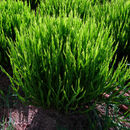Brief Summary
provided by IABIN
Diagnosis A large species (snout vent length greater than 120 mm) have distinct dorsolateral folds (four at least indicated by pattern in cases of indifferent preservation) and a distinct light stripe on the upper lip. The thigh patterns is contrasting light spots and lines on a dark background, but the spots are irregular, not discrete.
- author
- Esteban O. Lavilla
- editor
- Diego Arrieta
Distribution
provided by IABIN
Southern and southeastern Brazil and adjacent coastal islands from the northern part of the State of Santa Catarina, north to the State of Rio de Janeiro.
- author
- Esteban O. Lavilla
- editor
- Diego Arrieta
Molecular Biology
provided by IABIN
Flavonóides, lactonassesquiterpenos, óleo essencial (20)
Diagnostic Description
provided by IABIN
Adult morphology Females snout-vent length 130-139.4 mm, males snout-vent length 123.2-133.3 mm. Snout outline subovoid, rounded, or nearly rounded from above, rounded or obtusely rounded in profile; no cranial crests; no distinctive upper eyelid decoration; tympanum distinct and large, diameter greater than 1/2 to 3/4 diameter of eye; males with single, internal vocal sac; males with vocal slits; vomerine teeth in long forwardly arched transverse series, almost abutting medially. abutting posteromedial edges of choanae laterally: finger lengths II=IV
- author
- Esteban O. Lavilla
- editor
- Diego Arrieta
Comprehensive Description
provided by Smithsonian Contributions to Zoology
Leptodactylus flavopictus Lutz, 1926
Leptodactylus flavopictus Lutz, 1926a:144. [Type-locality: Mont Serrat, Itatiaia, Rio de Janeiro, Brazil. Holotype: Adolfo Lutz Collection 890, MNRio].
Leptodactylus pachyderma Miranda-Ribeiro, 1926:150–151. [Type-locality: Victoria Isle, São Paulo, Brazil. Holotype: MZUSp 351, adult female.]
DIAGNOSIS.—Specimens of flavopictus have distinct dorsolateral folds and a distinct light stripe on the upper lip. The other species in which some or all individuals share this combination of characteristics are rhodomystax and rhodonotus. Most individuals of rhodonotus lack a distinct light lip stripe. Individuals of flavopictus lack tubercles on the surfaces of the upper tibia and distal tarsus; individuals of rhodonotus have tuberculate upper tibial and distal tarsal surfaces. The posterior surface of the thigh of rhodomystax has a pattern of discrete, distinct light spots; the thigh patterns of flavopictus is contrasting light spots and lines on a dark background, but the spots are irregular, not discrete.
ADULT CHARACTERISTICS (N=16).—Dorsum lacking distinctive pattern (Figure 1, C); lip with broad or narrow light stripe from under eye to angle of jaw (Figure 2, G, H); posterior surface of thigh with contrasting pattern of light spots and lines on a dark background (Figure 3, F); upper tibia with broad continuous or broken bands (Figure 4, A, B); two weakly differentiated dorsolateral folds from eye to sacrum partly dark outlined; dark outlined fold from eye over tympanum to shoulder; no fold from above tympanum to side of body; male with two thumb spines per hand; male with chest spines; upper tibia and distal tarsus smooth; sole of foot smooth; female SVL 130.0±9.2 mm, maximum 139.4 mm, male SVL 123.2±6.1 mm, maximum 133.3 mm; female interorbital distance/head length ratio 0.19±0.02, male 0.18±0.02; female eye-nostril distance/head length ratio 0.25±0.01, male 0.24±0.01; female head length/SVL ratio 0.37±0.02, male 0.38±0.01; female head width/SVL ratio 0.40±0.01, male 0.39±0.02; female femur/SVL ratio 0.43±0.02, male 0.43±0.01; female tibia/SVL ratio 0.44±0.02, male 0.45±0.01; female foot/SVL ratio 0.47±0.02, male 0.48±0.02.
DISTINCTIVE COLORS IN LIFE.—Sides and belly with bright yellow wash and spotting (Lutz, 1926b, pl. 31).
LARVAL CHARACTERISTICS.—Oral disk anterior; oral disk entire; anterior split tooth row no more than ⅓ length of anterior entire tooth row, tooth row formula (from figs. 6 and 7 in Bokerman, 1957).
MATING CALL.—Bokermann (1957) described the call as a “Gluk, Gluk, Gluk,” sounding like the noise when a bottle of water is turned upside down. KARYOTYPE.—Unknown.
DISTRIBUTION (Figure 7).—Found in the Atlantic forest system of Brazil. Apparently the species is more abundant in the forests on some of the offshore islands than on the mainland.
BRAZIL. ESPÍRITO SANTO: Santa Tereza, Reserva Nova Lombardia (USNM 200454).
SĀO PAULO: Boracéia (MZUSP 21240): (USNM 209215); Ilha dos Búzios (MZUSP 21020, 24099–128); Paranapiacaba (MZUSP 10602, 11018).
- bibliographic citation
- Heyer, W. Ronald. 1979. "Systematics of the pentadactylus species group of the frog genus Leptodactylus (Amphibia, Leptodactylidae." Smithsonian Contributions to Zoology. 1-43. https://doi.org/10.5479/si.00810282.301
Leptodactylus flavopictus: Brief Summary
provided by wikipedia EN
Leptodactylus flavopictus is a species of frogs in the family Leptodactylidae.
It is endemic to Brazil. Its natural habitats are subtropical or tropical moist lowland forests and rivers. It is threatened by habitat loss.
- license
- cc-by-sa-3.0
- copyright
- Wikipedia authors and editors

